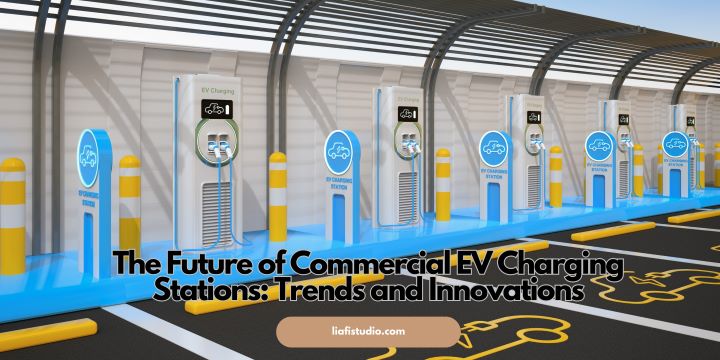Key Takeaways
- Commercial EV charging stations are essential for the growth of electric vehicle usage.
- Innovations in charging technology are making it faster and more convenient.
- Businesses are integrating EV charging stations to attract eco-conscious customers.
- Government incentives and policies are driving the expansion of EV infrastructure.
- Sustainability and renewable energy sources are becoming integral to EV charging solutions.
Table of Contents
- Introduction
- Importance of EV Charging Stations
- Current Trends in EV Charging
- Government Incentives and Policies
- Innovations in Charging Technology
- Sustainability and Renewable Energy
- Conclusion
Introduction
As electric vehicles (EVs) become increasingly popular, the demand for convenient and reliable charging stations is rising. An integral part of this infrastructure is the commercial EV charging station. This article will explore the future of commercial EV charging stations, focusing on emerging trends, technological advancements, and the role of government policies in this sector. Understanding the dynamics behind the rise in commercial EV charging stations can help businesses, policymakers, and consumers make informed decisions. These stations are not just about convenience; they are pivotal in transitioning to a more sustainable mode of transportation. As the shift towards electric mobility accelerates, a robust charging station network is essential to meet the growing demand. The continuous advancement in this field has set a trajectory for growth, with innovative solutions making EV charging more accessible and efficient than ever before.
Importance of EV Charging Stations
Charging stations for EVs are essential for their adoption. They provide the necessary infrastructure to support the growing number of electric vehicles on the road. A robust charging station network would significantly improve the transition to electric mobility. Charging stations ensure EV owners can conveniently recharge their cars at home, work, or on the go. This ease of access is vital for encouraging more people to switch to electric vehicles. Moreover, widespread EV charging infrastructure helps alleviate range anxiety, a primary concern for potential EV buyers. It guarantees them the ability to travel far distances without worrying about losing power.
Current Trends in EV Charging
One significant trend in the EV charging sector is the development of ultra-fast charging stations. These stations can significantly reduce the time it takes to charge an electric vehicle, making them more convenient for users. Additionally, many businesses are now integrating EV charging stations into their premises to attract environmentally conscious customers. This strategy enhances customer experience and boosts the business’s green credentials, aligning with the growing consumer demand for sustainable practices.
Another trend is the rise of charging stations equipped with smart technology. These stations can communicate with the grid to optimize energy usage and reduce costs. Smart EV chargers can adjust their output based on grid demand, charge during off-peak hours to save money, and even provide data to help utilities manage the grid more efficiently. These features make smart charging stations a valuable addition to the EV ecosystem. Intelligent chargers can also offer predictive maintenance by leveraging advanced analytics, reducing downtime and ensuring optimal performance. The global market for EV charging stations is expected to grow exponentially in the coming years, driven by increased EV sales and supportive government policies. This growth is indicative of a broader shift towards greener transportation solutions.
Government Incentives and Policies
Governments globally are implementing measures and encouragements to support the use of electric vehicles and the growth of EV charging infrastructure. These include subsidies for EV buyers, tax incentives for businesses that install charging stations, and grants for R&D in charging technology. Governments strive to speed up the shift to electric transportation, reduce greenhouse gas emissions, and improve energy security through financial aid and regulatory guidelines.
For example, the European Union has set ambitious targets for reducing carbon emissions, including extensive support for developing EV charging networks. These initiatives are part of a broader strategy to achieve climate neutrality by 2050. Extensive funding is allocated to create fast-charging corridors and enhance charging system interoperability across borders.
Innovations in Charging Technology
Recent technological advancements are making EV charging faster, more efficient, and more convenient. Wireless charging, for instance, eliminates the need for cables and connectors, making the charging process seamless for EV owners. By simply parking over a charging pad, EVs can automatically recharge, which enhances the user experience and reduces wear and tear on physical connectors. This technology also allows inductive charging embedded in roadways and continuous charging as vehicles drive.
Other innovations include bi-directional charging, which allows EVs to return electricity to the grid, and integration with renewable energy sources, ensuring that the electricity used to charge EVs is as green as possible. Bi-directional charging, also known as vehicle-to-grid (V2G) technology, can stabilize the grid by enabling electric vehicles to release stored energy when demand is highest. It supports grid reliability and offers potential cost savings for EV owners through energy arbitrage. Additionally, advancements in battery technology are enhancing charging speeds and energy density, making future EVs even more efficient.
Sustainability and Renewable Energy
Sustainability is a critical consideration in the development of EV charging infrastructure. Several charging stations are now powered by renewable energy sources like solar and wind power. It reduces the carbon footprint of EVs and ensures that the energy used is clean and sustainable. Incorporating renewable energy sources into EV charging networks can help develop a more sustainable and eco-friendly power system. Furthermore, using renewable energy in EV charging can contribute to decentralized energy generation, reducing reliance on traditional power plants and enhancing energy independence.
Conclusion
The future of commercial EV charging stations looks promising, with numerous trends and innovations driving the industry forward. As technology evolves and governments implement supportive policies, adopting electric vehicles and developing a robust charging infrastructure will only accelerate. Both businesses and consumers have the potential to gain from these improvements, leading the path toward a more environmentally friendly and long-lasting future. The collaboration between the public and private sectors is crucial in scaling the required infrastructure, ensuring that EV charging becomes as ubiquitous and reliable as conventional fuel stations.







